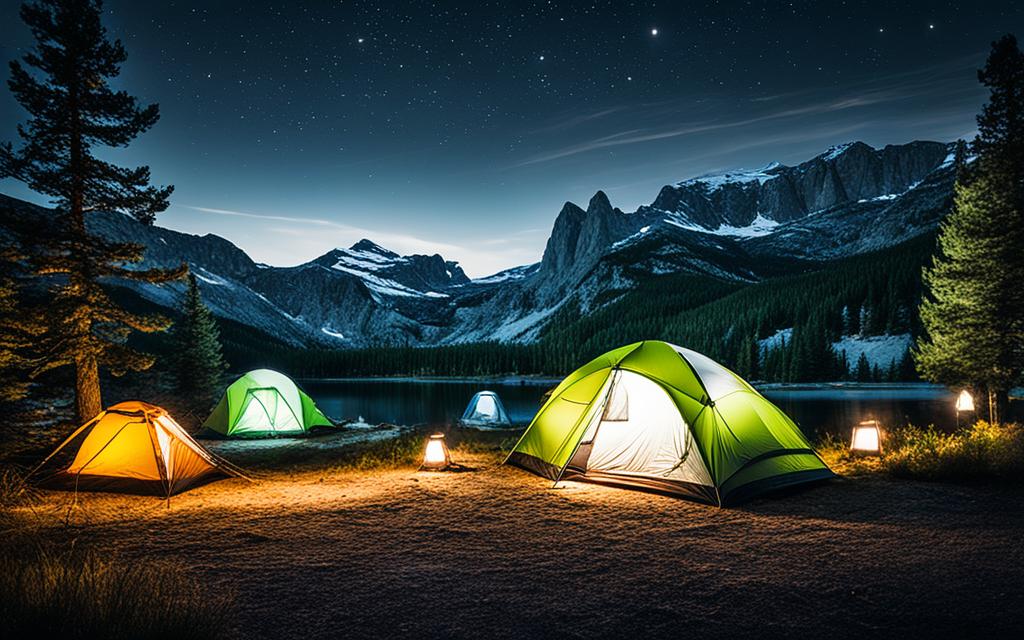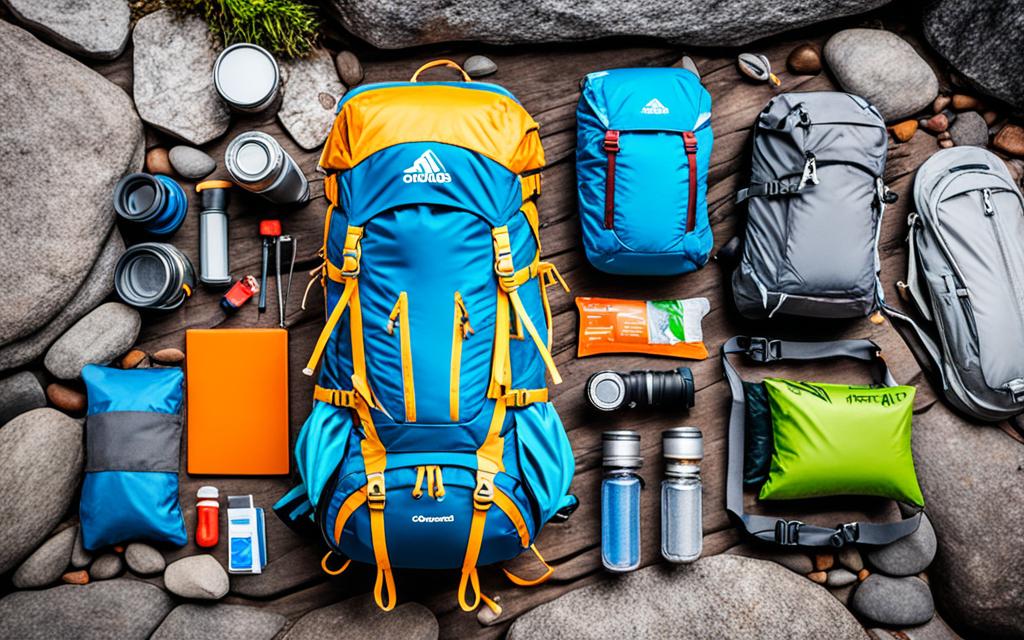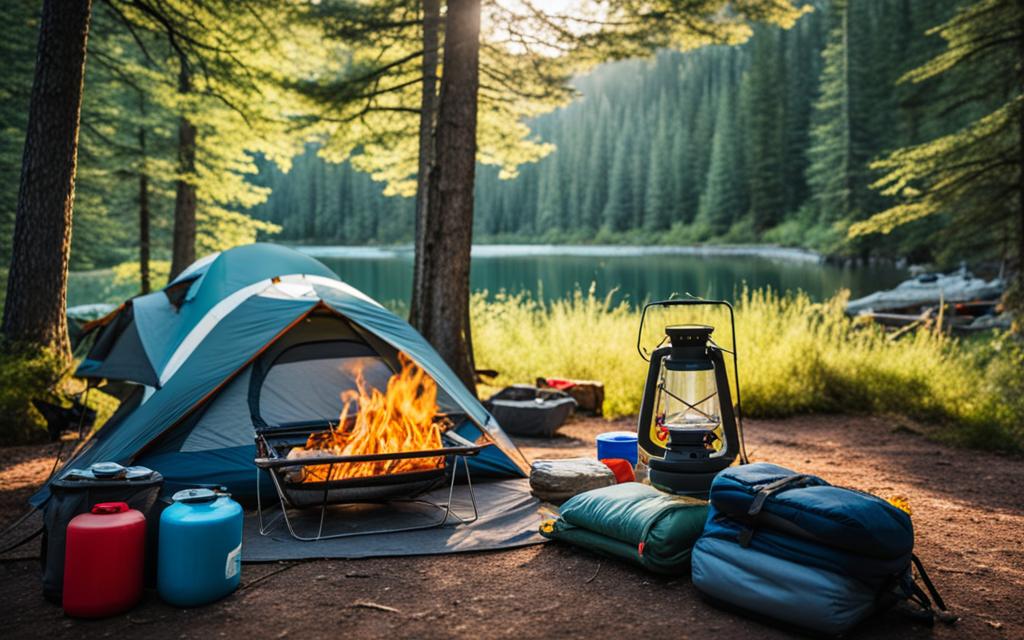When it comes to outdoor adventures, having the right camping equipment is essential. Whether you’re planning a weekend getaway or a week-long hiking trip, investing in high-quality gear can make a world of difference in your overall experience. From setting up camp to staying comfortable and safe, having the right equipment can ensure that you’re well-prepared for any situation that may arise.
In this section, we will explore the must-have camping equipment for your next outdoor adventure. From tents to sleeping bags and cookware, we’ll help you gear up and prepare for a memorable camping experience.
Key Takeaways:
- Invest in high-quality camping gear to ensure durability and longevity.
- Research and choose a tent that fits your specific needs, considering factors such as size, material, and weather resistance.
- Don’t overlook the importance of a comfortable sleeping bag and sleeping pad for a good night’s sleep.
- Be prepared with essential cookware and stoves to enjoy delicious meals at your campsite.
- Make sure to have reliable and efficient lighting options for when the sun goes down.
Choosing the Right Tent for Your Camping Trip
A good quality tent is an essential piece of camping equipment. Whether you’re embarking on a weekend getaway or a week-long adventure, having the right tent will ensure your comfort, protection, and enjoyment throughout your camping trip.
When choosing a tent, it’s important to consider several factors that will meet your specific needs and preferences. Let’s take a closer look at the key considerations:
Tent Size
The size of your tent will depend on the number of people you plan to accommodate and the amount of gear you need to store. Tents typically indicate the number of occupants they can comfortably fit, so consider if you prefer more room for extra gear or a snugger fit for minimalistic camping.
Material and Durability
Tents are made of various materials, each offering different levels of durability and weather resistance. Common tent materials include nylon, polyester, and canvas. Nylon and polyester tents are lightweight, easy to set up, and offer good water resistance. Canvas tents, on the other hand, are heavier but provide better insulation and durability.
Weather Resistance
Consider the climate conditions you’ll encounter during your camping trips. Look for a tent with a high waterproof rating to keep you dry during rainy weather. Additionally, tents with proper ventilation features will help to reduce condensation and maintain a comfortable environment inside the tent.
Setup and Portability
Quick and easy setup is always a plus when camping. Look for tents with simple assembly systems and lightweight materials for convenient transportation. Features like color-coded poles and intuitive designs can make a significant difference in reducing setup time and effort.
Other Features
Pay attention to additional features that may enhance your camping experience. This can include built-in storage pockets, vestibules for extra gear storage, multiple door access for convenience, and durable zippers that won’t jam easily.
Remember, investing in a high-quality tent is important for long-term camping adventures. It’s a vital component in ensuring a comfortable and enjoyable outdoor experience. Take your time in considering the aforementioned factors to choose the perfect tent that aligns with your camping needs.
Now that you have a better understanding of how to choose the right tent, let’s move on to the next section where we’ll discuss staying comfy with sleeping bags and sleeping pads.
Staying Comfy: Sleeping Bags and Sleeping Pads
A good night’s sleep is crucial when camping. To ensure you stay comfortable and warm throughout the night, it’s important to have the right sleeping gear. In this section, we’ll explore different types of sleeping bags and sleeping pads that are essential camping accessories.
Choosing the Perfect Sleeping Bag
When selecting a sleeping bag, there are several factors to consider. Insulation, weight, and temperature rating are key considerations in finding the right sleeping bag for your camping adventures.
“A comfortable, well-insulated sleeping bag is the foundation of a good night’s sleep in the great outdoors.”
Insulation is important for providing warmth during cold nights. Synthetic materials like polyester are great for insulation and are usually more affordable. On the other hand, down insulation offers lightweight warmth but can be pricier. Consider the climate and temperature range you’ll be camping in when selecting the appropriate insulation.
Weight is another critical factor, especially if you’ll be backpacking. Ultralight sleeping bags made with lightweight materials are ideal for those looking to cut down on pack weight. However, if you prioritize comfort and don’t mind the extra weight, regular sleeping bags provide more insulation and space.
Temperature rating is crucial for ensuring you stay warm throughout the night. Sleeping bags are typically assigned a temperature rating to indicate the coldest temperature at which they can keep the average person warm. It’s essential to select a bag that suits the expected temperature range of your camping destination.
Enhancing Comfort with Sleeping Pads
Sleeping pads provide an additional layer of comfort and insulation between you and the ground. They help cushion pressure points and provide insulation from the cold ground, ensuring a more restful sleep.
There are two main types of sleeping pads: self-inflating pads and air pads. Self-inflating pads are convenient and easy to use. They have open-cell foam that expands and inflates when the valve is opened. On the other hand, air pads require manual inflation using your breath or a pump but provide excellent comfort and insulation.
Key factors to consider when choosing a sleeping pad:
- Weight and packability: Look for lightweight and compact options if you need to save space in your backpack.
- Thickness and cushioning: Thicker pads offer more comfort and insulation, especially on uneven terrain.
- Durability: Consider the durability of the material and the pad’s resistance to punctures.
By investing in a high-quality sleeping bag and a comfortable sleeping pad, you’ll ensure a good night’s sleep and wake up refreshed and ready for your outdoor adventures.
Campsite Cooking: Essential Cookware and Stoves
Cooking delicious meals in the great outdoors is an integral part of the camping experience. Whether you’re enjoying a hearty breakfast before a day of hiking or cooking up a savory dinner under the stars, having the right cookware and stoves is essential to make your camping meals a success.
When it comes to campsite cooking, there is a wide range of options available to suit different camping styles and preferences. From lightweight backpacking stoves for minimalist adventurers to spacious camping cookware sets for family camping trips, choosing the right equipment can enhance your outdoor culinary experience.
“Cooking is at once child’s play and adult joy. And cooking done with care is an act of love.” – Craig Claiborne
Essential Cookware
When selecting cookware for camping, consider durability, versatility, and portability. Look for durable materials like stainless steel or aluminum that can withstand the rigors of outdoor cooking. Opt for non-stick coatings to make cooking and cleaning easier.
A versatile camping cookware set should include a pot for boiling water or cooking soups and stews, a frying pan for sautéing and frying, and possibly a kettle or coffee pot for hot beverages. Look for nesting sets that stack together to save space in your backpack or camping gear storage.
Stoves for Campsite Cooking
Portable stoves are essential for cooking meals at your campsite, providing a controlled heat source to prepare your dishes. Depending on your needs, you can choose from different types of stoves:
- Backpacking Stoves: These lightweight and compact stoves are perfect for backpacking or solo camping trips. They run on small fuel canisters and provide a reliable heat source to quickly boil water or heat up meals.
- Camping Stoves: These stoves are designed for larger camping groups and family trips. They typically run on propane or butane and offer multiple burners for simultaneous cooking.
Consider the fuel efficiency, ease of use, and stability of the stoves for your camping style. Look for stoves with wind screens and built-in igniters for added convenience.
Whether you’re simmering a mouthwatering stew or brewing a cup of coffee to kickstart your day, having the right cookware and stoves can elevate your campsite cooking experience. Choose quality equipment that suits your camping needs and enjoy delicious meals in the great outdoors.
Keeping It Bright: Efficient Lighting Options
When you’re out camping, having a reliable lighting source is crucial, especially when the sun goes down. In this section, we’ll explore different lighting options for your camping adventures, including lanterns, headlamps, and flashlights. We’ll discuss important features like brightness, battery life, and other factors to consider when choosing the right lighting gear for your outdoor experience.
1. Lanterns
One popular lighting option for camping is lanterns. These versatile sources of light provide a wide illumination range, making them ideal for illuminating a campsite or tent. Lanterns can be powered by batteries, propane, or even solar energy, offering you various options depending on your preferences and needs.
2. Headlamps
If you’re looking for hands-free lighting, headlamps are a great choice. These compact and lightweight devices are worn on your head, providing direct light wherever you look. Whether you’re cooking, reading, or exploring the campsite at night, a headlamp offers convenience and visibility, keeping your hands free to perform other tasks.
3. Flashlights
A flashlight is a camping essential that every outdoor enthusiast should have. These handheld light sources are compact, portable, and highly versatile. Flashlights come in various sizes and designs, offering different levels of brightness and beam distance. Look for durable flashlights with long battery life to ensure reliable lighting during your camping trips.
Remember to consider your specific needs and preferences when choosing the right lighting gear for your camping adventures. Whether you prefer the ambient glow of a lantern, the convenience of a headlamp, or the versatility of a flashlight, having efficient lighting options will enhance your camping experience and keep you safe in the great outdoors.

Staying Hydrated: Water Filters and Bottles
Proper hydration is crucial during outdoor adventures. When exploring the great outdoors, it’s important to have access to clean drinking water to keep you energized and hydrated throughout your camping trips. In this section, we’ll discuss water filters and bottles, essential camping equipment for ensuring a safe and reliable water source.
Types of Water Filters
Water filters are designed to remove impurities and contaminants from natural water sources, making them safe to drink. Here are some common types of water filters:
- Pump Filters: These filters use a hand pump to force water through a filtration system, removing bacteria, protozoa, and other harmful elements.
- Gravity Filters: Gravity filters are convenient for group camping as they use gravity to move water through a filter. They are easy to use and can filter large quantities of water at once.
- Straw Filters: Straw filters are lightweight and compact filters that allow you to drink directly from a water source. They are useful for solo backpackers or emergency situations.
Choosing the Right Water Bottle
Having a reliable water bottle is equally important. Consider the following factors when choosing a water bottle:
- Material: Look for bottles made from durable materials like stainless steel or BPA-free plastic. These materials are long-lasting, lightweight, and safe to use.
- Capacity: Determine how much water you need to carry based on the length and intensity of your outdoor activities. Choose a bottle with a suitable capacity to meet your hydration needs.
- Special Features: Some water bottles come with handy features like built-in filters, insulation, or straw lids for easy drinking on the go. Consider these features based on your camping preferences and requirements.
Pro Tip: It’s always a good idea to carry spare water filters and consider the estimated lifespan of your filter before heading out on an extended trip. Regularly check and maintain your filter to ensure it continues performing effectively.
By investing in reliable water filters and bottles, you can rest assured that you’ll have access to clean drinking water, no matter where your outdoor adventures take you.
Packing Efficiently: Backpacks and Gear Storage
A well-organized backpack can make a huge difference in your camping experience. Having the right backpack and gear storage solutions will ensure that you can pack and carry your camping equipment efficiently. Let’s explore some key factors to consider when choosing a backpack:
Capacity
First and foremost, you need to determine the right capacity for your backpack. Consider the duration of your camping trip and the amount of gear you’ll need to carry. Backpacks typically come in liter measurements, ranging from 20-80+ liters. A larger capacity is suitable for longer trips or if you need to carry bulkier gear like a tent or cooking equipment.
Comfort
Comfort is paramount when it comes to backpacks. Look for padded shoulder straps and a supportive back panel that provides proper ventilation. Adjustable straps and a hip belt help distribute the weight evenly, reducing strain on your shoulders and back. A comfortable backpack will make those long hikes to your campsite much more enjoyable.
Organization
Having a backpack with multiple compartments and pockets can make it easier to organize and access your gear. Look for backpacks with specialized compartments for items like water bottles, sleeping bags, and electronics. Additionally, consider backpacks with external attachment points that allow you to secure items like trekking poles or a camping mat.
Durability
Camping can be rough on your gear, so it’s important to choose a backpack that can withstand the elements. Look for backpacks made from durable materials such as nylon or polyester, which offer water resistance and tear strength. Reinforced stitching and sturdy zippers are also essential for long-lasting performance.
When it comes to gear storage, there are a few options to consider:
“An organized backpack can save you time and frustration when you’re out in the wild. Make sure your gear is well-protected and easy to access.” – Outdoor Enthusiast Magazine
Compression Bags
Compression bags are a great way to maximize space and keep your gear compact. These bags allow you to remove excess air, reducing the volume of your clothes, sleeping bags, and other soft items. They are especially useful when you need to fit bulky gear into a smaller backpack.
Dry Bags
If you’ll be camping near bodies of water or in wet environments, dry bags are a must-have. These waterproof bags keep your gear safe from water and moisture, ensuring that your clothes, electronics, and other sensitive items stay dry and in good condition.
Stuff Sacks
Stuff sacks are lightweight and versatile storage bags that can help keep your gear organized. Use them to pack clothes, carry food, or store small items like toiletries or cooking utensils. They come in various sizes and are easy to pack and unpack.
With the right backpack and gear storage solutions, you can pack efficiently and have all your essentials at hand during your camping adventures.

Safety First: Essential Camping Safety Gear
When embarking on a camping adventure, it’s important to prioritize safety. Having the right camping safety gear can make all the difference in ensuring a secure and enjoyable experience. Here are some essential camping equipment and accessories to consider:
First Aid Kits:
A well-stocked first aid kit is a must-have for any camping trip. Accidents and injuries can happen, so it’s crucial to be prepared. Make sure your first aid kit includes bandages, antiseptic wipes, pain relief medication, and other essentials. Remember to regularly check and replenish your first aid supplies to keep them up to date.
Fire Starters:
When camping, having the means to start a fire is essential for cooking food, staying warm, and providing a sense of security. Carry reliable fire starters, such as waterproof matches or a fire starter kit. These can help you start a fire quickly and efficiently, even in challenging weather conditions.
Navigation Tools:
Getting lost in the wilderness can be a scary experience, so having navigation tools is vital. Carry a map of the area you’ll be exploring, along with a compass or GPS device to help you navigate your surroundings. Familiarize yourself with the tools before your trip to ensure you can use them effectively.
Other Safety Gear:
In addition to first aid kits, fire starters, and navigation tools, there are other camping safety gear items to consider. These include a whistle for emergency signaling, a headlamp for hands-free lighting, a sturdy multi-tool for various tasks, and a reliable camping stove that ensures safe cooking. Always remember to prioritize safety and select gear that aligns with your specific camping needs.
By being prepared with essential camping safety gear, you can enjoy your outdoor adventures with peace of mind. Prioritize safety, and let your camping experience be memorable for all the right reasons.
